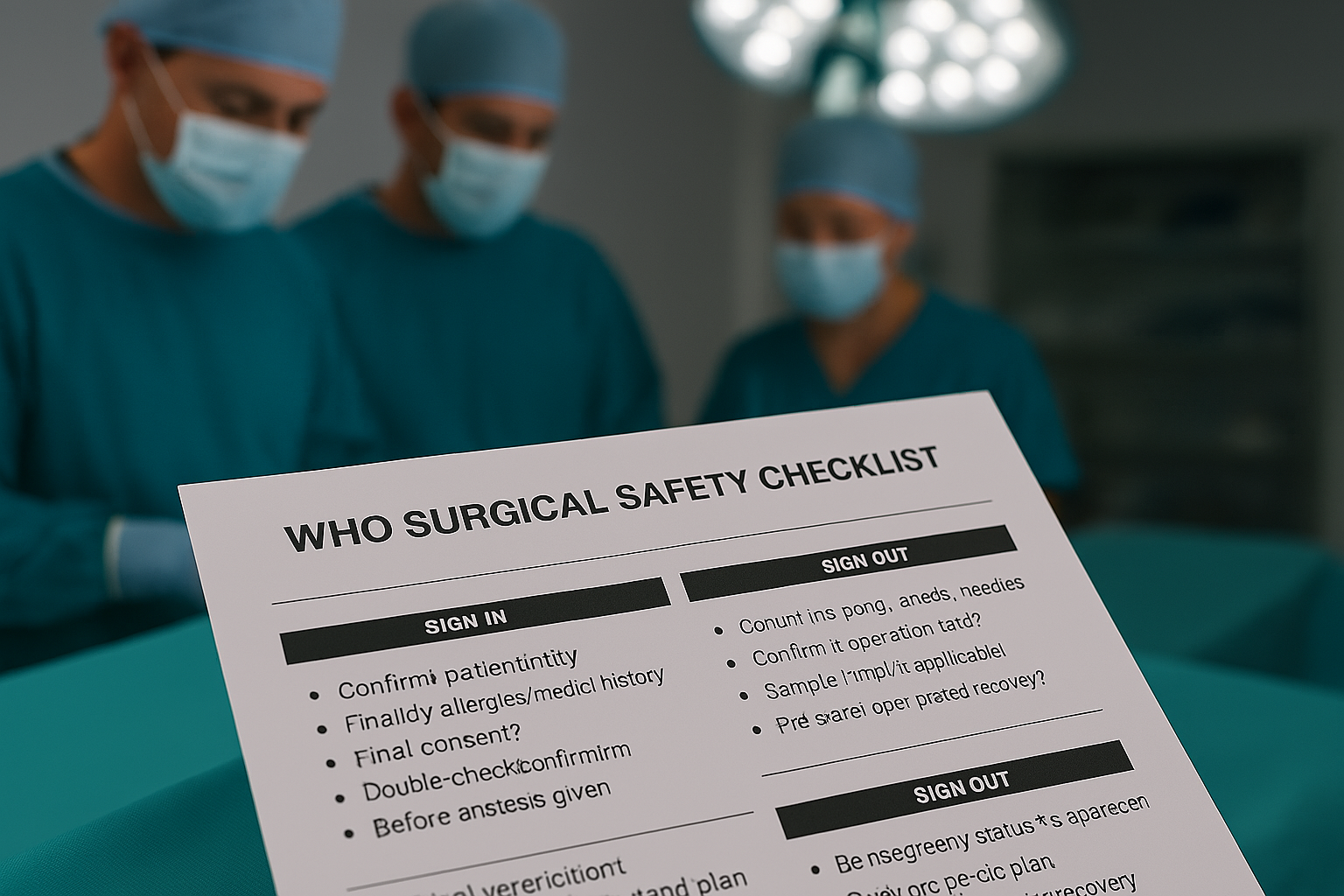Table of Contents
My First Encounter with the Surgical Safety Checklist
I still remember my first day inside the operating room as a new nurse. The quiet hum of monitors, the bright lights, and the team working in calm focus—it felt intense yet reassuring. Among all the equipment and protocols, one thing stood out to me right away: the surgical safety checklist.
At first glance, it looked simple, just a list of items to confirm before, during, and after surgery. But soon, I discovered how powerful the surgical safety checklist truly is in preventing mistakes and keeping patients safe.
What Is the Surgical Safety Checklist?
The surgical safety checklist was introduced by the World Health Organization (WHO) to make surgeries safer. It guides the entire team—surgeons, anesthetists, nurses—through critical checks at three key moments:
- Sign In – before anesthesia
- Time Out – before the first incision
- Sign Out – after the surgery is complete
It sounds simple, but this tool transforms how teams communicate, catch errors, and protect patients.
Sign In: Starting with Safety
The first part of the surgical safety checklist is called Sign In, done before anesthesia begins. This step helps ensure we’re fully prepared.
Here’s what we typically check:
- Confirming the correct patient name and procedure
- Reviewing allergies and medical history
- Making sure all required equipment is ready and functional
Once, thanks to this step, we found an unrecorded latex allergy that could have caused serious complications. That moment showed me why the surgical safety checklist matters so much.
Time Out: The Pause That Saves Lives
Just before surgery starts, everyone stops for a Time Out. It’s the heart of the surgical safety checklist, and its purpose is clear communication.
During Time Out, the team:
- Confirms the correct surgical site and procedure
- Discusses the surgical plan and any special concerns
- Encourages everyone, from surgeons to scrub nurses, to speak up
I’ll never forget a day when the drape was mistakenly placed on the wrong side. Because the surgical safety checklist made it normal to question things, I spoke up, and we corrected the mistake before it became a serious error.
Sign Out: Ending with Confidence
At the end of the surgery, the Sign Out part of the surgical safety checklist brings the team together to review and confirm:
- That the procedure was completed as planned
- All instruments and sponges are accounted for
- The patient is stable and ready for recovery
This final step helps prevent forgotten tools inside the patient—a risk that, although rare, can have severe consequences.
Why the Surgical Safety Checklist Is So Important
The surgical safety checklist does more than just tick boxes:
✅ It prevents avoidable mistakes
✅ Promotes teamwork and open communication
✅ Reduces surgical infections and complications
✅ Reassures patients that safety is a shared priority
By following the surgical safety checklist, every person in the OR helps protect patient lives.
How It Empowers Nurses
For nurses like me, this safety checklist is more than a protocol—it’s a chance to be heard. It helps us:
- Confirm patient information
- Ask clarifying questions
- Raise safety concerns without hesitation
This checklist has made me feel confident to speak up, even as a newer member of the surgical team.
Real Impact of the Safety Checklist
Research shows that using the surgical safety checklist:
- Can reduce complications by over 30%
- Lowers infection rates
- Encourages better teamwork and communication
These aren’t just numbers—they’re real people who experience safer surgeries and faster recoveries.
Daily Tips for Using the WHO Checklist
To keep the surgical safety checklist effective, our team:
✅ Takes each section seriously—even on busy days
✅ Encourages every team member to speak up
✅ Reviews patient details, allergies, and equipment
✅ Treats it as a conversation, not just paperwork
This routine helps the surgical safety checklist stay meaningful.
What the Surgical Safety Checklist Means to Me
Over time, the surgical safety checklist taught me:
- Patient safety is never automatic—it must be checked
- Every detail, even small ones, matters deeply
- Communication saves lives
- Nurses have a powerful role in catching potential mistakes
It has become part of how I define good nursing care.
How Patients Benefit Without Seeing It
Patients rarely see the surgical checklist, but they feel its effect:
- Fewer infections and complications
- Shorter hospital stays
- Greater peace of mind knowing their surgical team follows proven safety steps
One patient told me, “Your team seemed so organized; it made me feel safe.” That trust comes directly from the surgical safety checklist.
.
Join our Email List Today!
We’d love to stay in touch and keep you updated with the latest insights and resources!
- Stay informed with exclusive content and updates.
- Receive expert tips and valuable resources directly in your inbox.
- Be the first to know about new articles, events, and more!
Fill out the form to subscribe now and be part of our growing community!
Let’s keep the learning and excitement going! 📚✨🏥
For more insights into the daily work of an operating room nurse or the challenges faced in surgery, explore our posts on Navigating Your First Year in Nursing and Sterility Matters: Why Theatre Nurses Are Essential in the OperatingTheatre.
You can find more details about the WHO Surgical Safety Checklist on their official page here
.
SUBSCRIBE TO MY YOUTUBE
Want to see what nursing looks like beyond the written word? Join me on YouTube
where I dive deeper into topics like surgical safety, emotional wellness, and real behind-the-scenes moments from a nurse’s perspective.
Subscribe today and be part of a growing community that empowers caregivers and celebrates the heart of healthcare.
